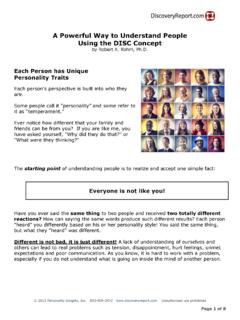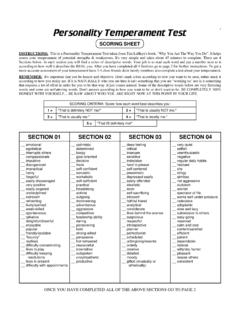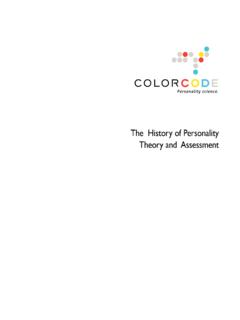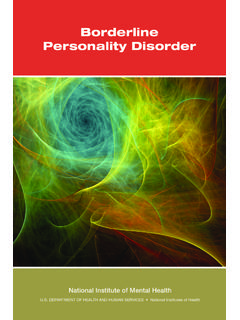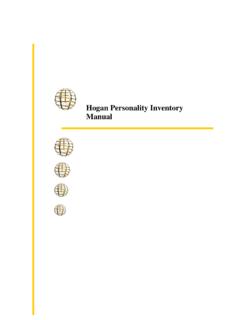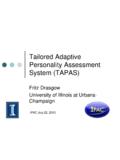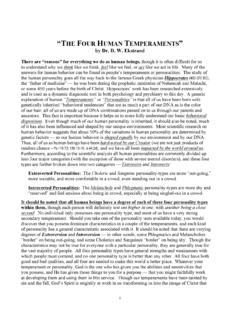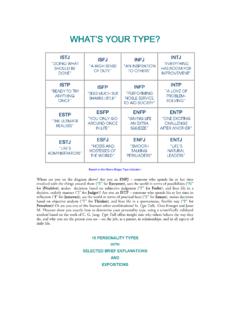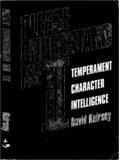Transcription of A Powerful Way to Understand People - Discovery …
1 A Powerful Way to Understand People Using the DISC Concept by Robert A. Rohm, Each Person has Unique personality Traits Each person's perspective is built into who they are. Some People call it personality and some refer to it as temperament.. Ever notice how different that your family and friends can be from you? If you are like me, you have asked yourself, "Why did they do that?" or "What were they thinking?". The starting point of understanding People is to realize and accept one simple fact: Everyone is not like you! Have you ever said the same thing to two People and received two totally different reactions? How can saying the same words produce such different results? Each person heard you differently based on his or her personality style!
2 You said the same thing, but what they "heard" was different. Different is not bad, it is just different! A lack of understanding of ourselves and others can lead to real problems such as tension, disappointment, hurt feelings, unmet expectations and poor communication. As you know, it is hard to work with a problem, especially if you do not Understand what is going on inside the mind of another person. 2013 personality Insights, Inc. 800-509-3472 Unauthorized use prohibited Page 1 of 8. There IS a Simple Way to Understand People ! The good news is that there is a simple key to Understand how People behave and how they are motivated. We call the concept The DISC Model of Human Behavior. This concept will allow you to unlock the mystery behind developing good People skills and creating better relationships.
3 You will be able to use what you learn in this introduction to reduce conflict, improve productivity and relate with others more effectively. Some Background on the DISC Model of Human Behavior Twenty-four hundred years ago, scientists and philosophers, most notably Hippocrates, began to recognize and categorize differences in behavior that seemed to follow a pattern. Since then, many psychologists and scientists have explored behavioral patterns. Dr. William Marston wrote The Emotions of Normal People in 1928. after earning his doctorate from Harvard University. Marston theorized that People are motivated by four intrinsic drives that direct behavioral patterns. He used four descriptive characteristics for behavioral tendencies which are represented by four letters of the alphabet: D, I, S and C.
4 Thus the concept of DISC was introduced. On a side note - I learned about DISC over 25 years ago from a good friend who helped me to Understand my daughter. The concept was so revolutionary in my own family that I began my own research. Since then I have trained thousands of People and written many books on the subject. No one is more passionate about what I am sharing with you than I am, because these are the very concepts that changed my life! Building on a "Wellness" Model Many behavioral models focus on what is wrong with a person to identify " personality disorders." The DISC model is based on normal behavior, not abnormal behavior. DISC is a "wellness model" that is objective and descriptive rather than subjective and judgmental.
5 Therefore, DISC is a practical way to Understand yourself and those around in the common settings of everyday life. 2013 personality Insights, Inc. 800-509-3472 Unauthorized use prohibited Page 2 of 8. A Positive Approach The DISC wellness model is a good framework for understanding People . DISC should be used in a positive way to encourage a person to be his or her best not as a way to label someone. Healthy, positive relationships come from having an accurate understanding of yourself and others. DISC is a Powerful tool for obtaining a new appreciation for our personality styles and their effect on our everyday lives. We apply the DISC model with four main ideas that allow it to be used appropriately as an effective and encouraging tool: We use a POSITIVE approach to highlight and encourage a person in his or her STRENGTHS.
6 We use a POSITIVE approach to address a person's possible BLIND- SPOTS without assuming a weakness exists. We recognize that each person has a unique blend of ALL the major personality traits to a greater or lesser extent. We recognize that behavioral patterns are fluid and dynamic as a person adapts to his or her environment. I have a saying that, your strengths should carry you while your blind-spots should concern you. Being able to identify and articulate your strengths can be very empowering. Being able to identify and uncover blind-spots can also be very empowering! The next few pages can be the start of your own empowering Discovery process. So, now that you know where the DISC concept came from and the importance of having a positive, flexible approach, let's take a look at the Model of Human Behavior using the DISC!
7 2013 personality Insights, Inc. 800-509-3472 Unauthorized use prohibited Page 3 of 8. The DISC Model of Human Behavior The model of human behavior is based on 2 foundational observations about how People normally behave: Observation #1: Some People are more OUTGOING, while others are more RESERVED. You can think of this trait as each person's "internal motor" or pace. Some People always seem ready to "go" and "dive in" quickly. They engage their motor quickly. Others tend to engage their motor more slowly or more cautiously. Observation # 2: Some People are more TASK-ORIENTED, while others are more People -ORIENTED. You can think of this as each person's external focus or priority that guides them. Some People are focused on getting things done (tasks); others are more tuned-in to the People around them and their feelings.
8 With both observations, we want to emphasize that these behavioral tendencies are neither right or wrong or good or bad. They are just different. We are simply identifying normal behavior styles. People have different styles, and that is okay. We represent these 2 observations in the diagrams below. 2013 personality Insights, Inc. 800-509-3472 Unauthorized use prohibited Page 4 of 8. Four Major personality Traits In review, we have 4 behavioral tendencies to help us characterize People : Outgoing Reserved Task-oriented People -oriented Everyone has some of all 4 of these tendencies at different times and in different situations. However, most People typically have 1 or 2 of these tendencies that seem to fit them well in their everyday behavior.
9 And, on the other hand, 1 or 2 of these tendencies usually do not fit them well, and these tendencies may even seem "foreign" to their approach to life. The balance of these 4 tendencies shapes the way each person "sees" life and those around them. By combining the 2 previous diagrams, we can show 4 basic quadrants of the circle as shown below: Four Major personality Traits / Tendencies Thus, 4 basic personality traits emerge from our diagram corresponding to the 4. quadrants of the circle (In clockwise order): Outgoing and Task-oriented (upper left quadrant). Outgoing and People -oriented (upper right quadrant). Reserved and People -oriented (lower right quadrant). Reserved and Task-oriented (lower left quadrant).
10 Next, we will add descriptive terms for each of the four main personality types that emerge in the diagram. The descriptive terms will begin with D, I, S and C. 2013 personality Insights, Inc. 800-509-3472 Unauthorized use prohibited Page 5 of 8. Describing Each personality Style (4 Different Types - 4 Different Priorities). As mentioned before, we will add the descriptive terms to the diagram. Notice the letters D, I, S and C appear in the 4 quadrants of the circle in the diagram below. You will also notice that descriptive terms have been added in each of the 4 corners of the diagram. D-I-S-C Descriptive Terms Now we can further describe each of the four main personality styles: The Dominant "D" type - An outgoing, task-oriented individual will be focused on getting things done, accomplishing tasks, getting to the bottom line as quickly as possible and MAKING IT HAPPEN!
